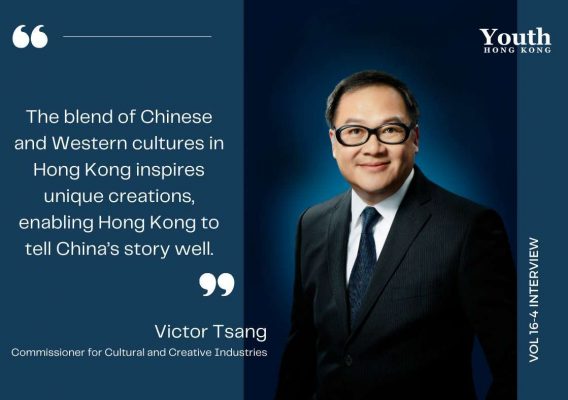//16.4 Interview: Victor Tsang
How does Hong Kong embrace its role as an “East-meets-West centre” and nurture a new generation of storytellers? Victor Tsang, Commissioner for Cultural and Creative Industries, shares some insights.
From pop stars Leslie Cheung and Anita Mui, to the legendary Jackie Chan and beloved animation icons like McDull, many famous figures represent Hong Kong’s golden age of pop culture and evoke a deep sense of nostalgia. Having undergone rising competition and historic changes over the years, the city has set clear goals for its culture, arts and creative industries, and the recent publication of the Blueprint for Arts and Culture and Creative Industries Development in November 2024 marked a pivotal moment.
The Blueprint outlines these goals and other measures for developing and revitalising these sectors. It is a comprehensive official document envisioning a future cultural landscape for Hong Kong that is more diversified, appealing, and influential, further consolidating its position as an East-meets-West centre for international cultural exchanges. In this written interview, Victor Tsang, JP, Commissioner for Cultural and Creative Industries, previously the Head of Create Hong Kong, the organisation which has been restructured to the Cultural and Creative Industries Development Agency (CCIDA), shares his views on the latest Hong Kong arts, culture and creative industry landscape. He also speaks of the government’s vision, as set out in the Blueprint, and ongoing initiatives that aim to nurture a new generation of talent.
The New Boom
Commissioner Tsang thinks Hong Kong’s arts, culture and creative industries have experienced a new boom over the past two decades, with significant growth bolstered by enhanced government support and expanded resources. This can be seen in the substantial increase in infrastructure development and funding, he says.
Currently, the Leisure and Cultural Services Department (LCSD) manages a network of 15 museums, two visual art centres, and 16 performing arts venues. Upon the gradual completion of more cultural facilities, there will be an even more robust foundation for the city’s creative and cultural activities.
Funding for these sectors has also seen a remarkable rise, with government spending increasing by 76% over the past decade, from HK$4.15 billion in 2015-16 to HK$7.31 billion in 2024-25. Investment has spanned various initiatives, including the Film Development Fund and the CreateSmart Initiative. Additionally, the city has seen a growing number of large-scale arts and cultural events.
Highlighting the government’s more proactive role in fostering cultural and creative industries, the Commissioner remarks that the CCIDA actively connects with industry communities in Hong Kong and around the world to bring in new inspirations in its work. It also acts as a facilitator to support diverse collaborations which are conducive to the diverse development of culture and creative industries of Hong Kong, while encouraging more participation from business sectors at the same time. “CCIDA has been closely liaising with various industries and organisations to maximise collective efforts and impact,” he notes.
The Blueprint
As the city strives to revive its post-pandemic economy, the Hong Kong government’s Blueprint for Arts and Culture and Creative Industries Development lists 71 measures and sets out clear visions and long-term developmental directions. This comprehensive document, says Commissioner Tsang, came “at the right moment” under the 14th Five-Year Plan, which highlighted Hong Kong’s position as an “East-meets-West centre for international cultural exchange.”
Commissioner Tsang thinks this national plan is a key opportunity for Hong Kong to leverage its strengths as a connector between our country and the rest of the world. Among those advantages, Hong Kong’s cultural perspective that blends the East and the West with its roots entrenched in the Chinese culture is key to the future development of the industry.
“We must take advantage of the ‘East-meets-West centre for international cultural exchange’ and promote Chinese culture internationally through globalised curation and creative techniques. Chinese culture has provided a continuous and inexhaustible source of nourishment and inspiration for Hong Kong’s cultural and artistic community,” he continues. “The blend of Chinese and Western cultures in Hong Kong inspires unique creations, enabling Hong Kong to tell China’s story well.”
Public reactions towards the Blueprint have been positive until this day. However, the path forward is not without challenges. With the rapid development of pop culture in neighbouring regions and rising competition, Hong Kong’s edge in this sector is sometimes diminished by a shortage of venues, talent, and support from the private sector. Fortunately, the market and opportunities provided by the country, according to the Commissioner, will help Hong Kong’s cultural arts and creative industries break through these limitations.
He further added that the newly launched DX design hub operated by the Hong Kong Design Centre (HKDC) is an example of redevelopment to an art design space from an old residential building in Sham Shui Po district, once the birthplace of Hong Kong’s clothing and textile wholesale and retail industry.
To achieve the vision listed in the Blueprint, says the Commissioner, one crucial success factor lies in cross-sector collaboration. “While Hong Kong creators produce outstanding works, we need more collaborations across different sectors and cultural fields to maximise economic benefits.” He says the rapid development of the creative industries not only directly creates job opportunities and generates economic returns, but also creates a “ripple effect” that stimulates the entire economy and generates more business opportunities.
The vision is expected to revitalise the city’s economy and create more job opportunities, which has been largely driven by the finance, trading and logistics industries. As projected in the Blueprint, the arts, culture and creative industries will increase their economic contribution by 66%, from about HK$120 billion in 2022 to HK$200 billion by 2034, alongside an expected rise in jobs from about 220,000 to 264,000.
A brief timeline of Hong Kong’s arts, cultural and creative initiatives
1984 The Hong Kong Academy for Performing Arts
1995 The Hong Kong Arts Development Council
1999 The Film Development Fund
2000 Culture and Heritage Commission
2009 Create Hong Kong
2022 Culture, Sports and Tourism Bureau
2024 Create Hong Kong, restructured as the Cultural and Creative Industries Development Agency (CCIDA)
Nurturing Hong Kong Storytellers
The CCIDA has consistently supported industry professionals, particularly emerging talents in the cultural and creative sectors. The government agency, restructured from “Create Hong Kong” in 2024, manages government funding allocated to support the development of film and other creative sectors. Through initiatives like the “Film Development Fund,” it has focused on four major directions: talent training, enhancing the development of local film production and startups, expanding markets, and fostering a more creative atmosphere in communities.
Notable films that have received funding from this initiative include popular titles such as Time Still Turns The Pages (年少日記), A Guilty Conscience (毒舌大狀) and Love Lies (我談的那場戀愛). As of June 2024, over 100 films have been funded by the Film Development Fund, involving more than 100 emerging directors and producers, and achieving over 160 local and international awards.
The commissioner highlighted several successful talent incubation or support programs like the First Feature Film Initiative, the Next Writer Publication Funding Scheme, Animation Support Program, and Hong Kong Comics Support Programme.
Among these, the First Feature Film Initiative aims to provide potential young filmmakers the opportunity to create their first feature films, even if they have zero experience in long-form filmmaking, according to Commissioner Tsang. This initiative has led to the production of several recent popular films.
“Hong Kong creators are capable of telling great stories,” he says. For example, the recent film The Last Dance (破·地獄) has become a hot topic in the city. It explores the themes of life and death through the traditional procedures and rituals that occur during funerals. With the strong support from Hong Kong audience, the film has recorded over HK$120 million at the box office since its release. “One of the factors contributing to this film’s success,” says the Commissioner, “is its ability to showcase Hong Kong’s unique culture while conveying inspiring values and messages resonating to the audience.”
The future development of Hong Kong’s cultural and creative industries relies on the involvement of young people. Commissioner Tsang thinks Hong Kong’s young generation should broaden their cultural horizons to enhance their competitiveness. This can be achieved by visiting the Mainland and overseas countries to learn about their diverse cultures, customs, and traditions, as well as actively participating in various exchange programmes and competitions. ■





